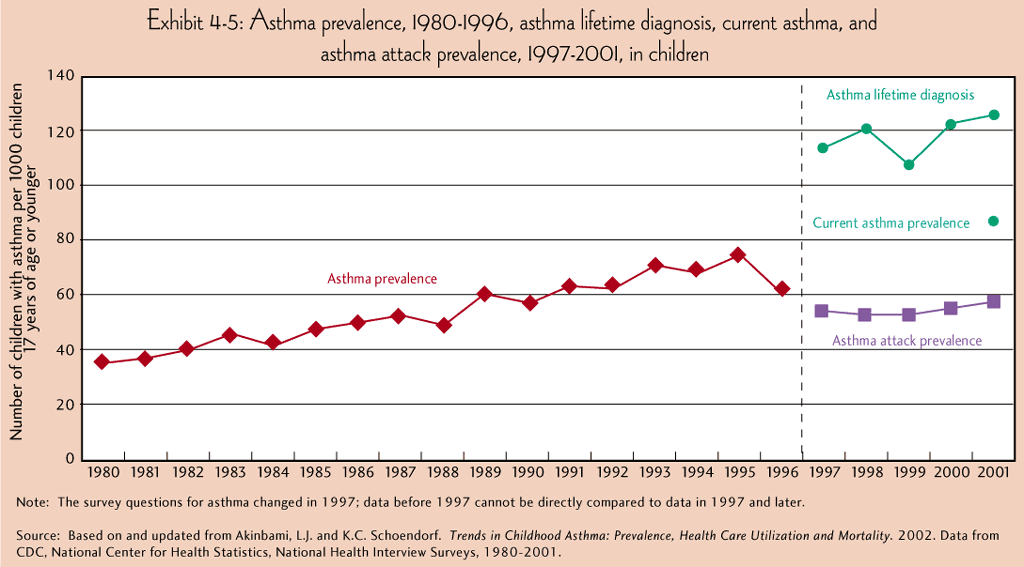Asthma epidemiology and demographics
Editor-in-Chief: C. Michael Gibson, M.S., M.D.; Philip Marcus, M.D., M.P.H. [1], Division of Pulmonary Medicine St. Francis Hospital-The Heart Center, Roslyn, NY
Epidemiology

More than 6% of children in the United States have been diagnosed with asthma, a 75% increase in recent decades. The rate soars to 40% among some populations of urban children.
Asthma is usually diagnosed in childhood. The risk factors for asthma include:
- a personal or family history of asthma or atopy;
- triggers (see Pathophysiology above);
- premature birth or low birth weight;
- viral respiratory infection in early childhood;
- maternal smoking;
- being male, for asthma in prepubertal children; and
- being female, for persistence of asthma into adulthood.
There is a reduced occurrence of asthma in people who were breast-fed as babies. Current research suggests that the prevalence of childhood asthma has been increasing. According to the Centers for Disease Control and Prevention's National Health Interview Surveys, some 9% of US children below 18 years of age had asthma in 2001, compared with just 3.6% in 1980 (see figure). The World Health Organization (WHO) reports that some 8% of the Swiss population suffers from asthma today, compared with just 2% some 25–30 years ago.[1] Although asthma is more common in affluent countries, it is by no means a problem restricted to the affluent; the WHO estimate that there are between 15 and 20 million asthmatics in India. In the U.S., urban residents, Hispanics, and African Americans are affected more than the population as a whole. Globally, asthma is responsible for around 180,000 deaths annually.[1]
On the remote South Atlantic island Tristan da Cunha, 50% of the population are asthmatics due to heredity transmission of a mutation in the gene CC16.
Socioeconomic factors
The incidence of asthma is higher among low-income populations within a society (it is not more common in developed countries than developing countries [2]), which in the western world are disproportionately ethnic minorities, and more likely to live near industrial areas. Additionally, asthma has been strongly associated with the presence of cockroaches in living quarters, which is more likely in such neighborhoods.[2]
Asthma incidence and quality of treatment varies among different racial groups, though this may be due to correlations with income (and thus affordability of health care) and geography. For example, Black Americans are less likely to receive outpatient treatment for asthma despite having a higher prevalence of the disease. They are much more likely to have emergency room visits or hospitalization for asthma, and are three times as likely to die from an asthma attack compared to whites. The prevalence of "severe persistent" asthma is also greater in low-income communities compared with communities with better access to treatment.[3][4]
Asthma and athletics
Asthma appears to be more prevalent in athletes than in the general population. One survey of participants in the 1996 Summer Olympic Games, in Atlanta, Georgia, U.S., showed that 15% had been diagnosed with asthma, and that 10% were on asthma medication. [5] These statistics have been questioned on at least two bases. Athletes with mild asthma may be more likely to be diagnosed with the condition than non-athletes, because even subtle symptoms may interfere with their performance and lead to pursuit of a diagnosis. It has also been suggested that some professional athletes who do not suffer from asthma claim to do so in order to obtain special permits to use certain performance-enhancing drugs.
There appears to be a relatively high incidence of asthma in sports such as cycling, mountain biking, and long-distance running, and a relatively lower incidence in weightlifting and diving. It is unclear how much of these disparities are from the effects of training in the sport, and from self-selection of sports that may appear to minimize the triggering of asthma.[5][6]
In addition, there exists a variant of asthma called exercise-induced asthma that shares many features with allergic asthma. It may occur either independently, or concurrent with the latter. Exercise studies may be helpful in diagnosing and assessing this condition.
References
- ↑ 1.0 1.1 World Health Organization. "Bronchial asthma: scope of the problem".
- ↑ "Patient/Public Education: Fast Facts - Asthma Demographics/Statistics". American Academy of Allergy Asthma & Immunology.
- ↑ National HAeart, Lung, and Blood Institute (May 2004). "Morbidity & Mortality: 2004 Chart Book On Cardiovascular, Lung, and Blood Diseases". National Institutes of Health.
- ↑ National Center for Health Statistics (07 April 2006). "Asthma Prevalence, Health Care Use and Mortality, 2002". Centers for Disease Control and Prevention. Check date values in:
|year=(help) - ↑ 5.0 5.1 Weiler JM, Layton T, Hunt M. Asthma in United States Olympic athletes who participated in the 1996 Summer Games. J Allergy Clin Immunol. 1998;102(5):722-6. PMID 9819287
- ↑ Helenius I, Haahtela T. Allergy and asthma in elite summer sport athletes. J Allergy Clin Immunol. 2000;106(3):444-52 PMID 10984362